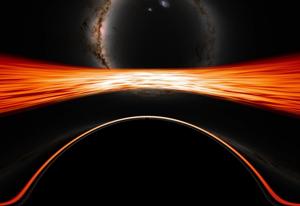
By Dean Murray via SWNS
Scientists have shown what it would be like to plunge into a black hole.
Thanks to a new, immersive visualization produced on a NASA supercomputer, viewers can plunge into the event horizon, a black hole’s point of no return.
The simulation tracks a camera as it approaches, briefly orbits, and then crosses the event horizon of a monster black hole much like the one at the center of our galaxy.
Jeremy Schnittman, NASA astrophysicist at Goddard Space Flight Center in Maryland, created the visualizations.
#bwg_container1_0 #bwg_container2_0 #bwg_mosaic_thumbnails_div_0 { width: 100%; position: relative; background-color: rgba(255, 255, 255, 0.00); text-align: center; justify-content: center; margin-left: auto; margin-right: auto; padding-left: 2px; padding-top: 2px; } #bwg_container1_0 #bwg_container2_0 .bwg_mosaic_thumb_spun_0 { display: block; position: absolute; border-radius: 0; border: 0px none #CCCCCC; background-color:rgba(0,0,0, 0.30); -moz-box-sizing: content-box !important; -webkit-box-sizing: content-box !important; box-sizing: content-box !important; } #bwg_container1_0 #bwg_container2_0 .bwg_mosaic_thumb_0 { display: block; -moz-box-sizing: content-box !important; -webkit-box-sizing: content-box !important; box-sizing: content-box !important; margin: 0; opacity: 1.00; } #bwg_container1_0 #bwg_container2_0 .bwg_mosaic_thumb_spun_0:hover { opacity: 1; backface-visibility: hidden; -webkit-backface-visibility: hidden; -moz-backface-visibility: hidden; -ms-backface-visibility: hidden; z-index: 102; } @media only screen and (min-width: 480px) { #bwg_container1_0 #bwg_container2_0 .bwg-container-0.bwg-mosaic-thumbnails .bwg-item0 img { -webkit-transition: -webkit-transform .3s; transition: transform .3s; } #bwg_container1_0 #bwg_container2_0 .bwg-container-0.bwg-mosaic-thumbnails .bwg-item0 img:hover { -ms-transform: scale(1.08); -webkit-transform: scale(1.08); transform: scale(1.08); } } #bwg_container1_0 #bwg_container2_0 .bwg_mosaic_thumbnails_0 { background-color: rgba(255, 255, 255, 0.00); font-size: 0; position: relative; text-align: center; display: inline-block; visibility: hidden; } /*image title styles*/ #bwg_container1_0 #bwg_container2_0 .bwg_mosaic_title_spun1_0, #bwg_container1_0 #bwg_container2_0 .bwg-mosaic-thumbnails .bwg_ecommerce_spun1_0 { position: absolute; display: block; opacity: 0; box-sizing: border-box; text-align: center; top: 50%; left: 50%; transform: translate(-50%, -50%); } #bwg_container1_0 #bwg_container2_0 .bwg-mosaic-thumbnails .bwg_mosaic_title_spun2_0, #bwg_container1_0 #bwg_container2_0 .bwg-mosaic-thumbnails .bwg_ecommerce_spun2_0 { color: #323A45; font-family: Ubuntu; font-size: 16px; font-weight: bold; text-shadow: ; vertical-align: middle; word-wrap: break-word; } .bwg_mosaic_play_icon_spun_0 { display: table; position: absolute; left: -10000px; top: 0px; opacity: 0; } .bwg_mosaic_play_icon_0 { color: #323A45; font-size: 32px; vertical-align: middle; display: table-cell !important; z-index: 1; text-align: center; margin: 0 auto; } #bwg_container1_0 #bwg_container2_0 .bwg_gal_title_0 { background-color: rgba(0, 0, 0, 0); color: #323A45; display: block; font-family: Ubuntu; font-size: 16px; font-weight: bold; padding: 2px; text-shadow: ; text-align: center; } @media screen and (max-width: 350px) { div[class^=”bwg_mosaic_thumbnails_”], span[class^=”bwg_mosaic_thumb_spun_”] { width: 100% !important; } img[class^=”bwg_mosaic_thumb_”] { width: 100% !important; height: auto !important; margin: 0px auto !important; } }
#bwg_container1_0 #bwg_container2_0 #spider_popup_overlay_0 { background-color: #EEEEEE; opacity: 0.60; }
He says: “People often ask about this, and simulating these difficult-to-imagine processes helps me connect the mathematics of relativity to actual consequences in the real universe.
“So I simulated two different scenarios, one where a camera — a stand-in for a daring astronaut — just misses the event horizon and slingshots back out, and one where it crosses the boundary, sealing its fate.”
To create the visualizations, Schnittman teamed up with fellow Goddard scientist Brian Powell and used the Discover supercomputer at the NASA Center for Climate Simulation.
The project generated about 10 terabytes of data — equivalent to roughly half of the estimated text content in the Library of Congress — and took about 5 days running on just 0.3% of Discover’s 129,000 processors. The same feat would take more than a decade on a typical laptop.
The destination is a supermassive black hole with 4.3 million times the mass of our Sun, equivalent to the monster located at the center of our Milky Way galaxy.
“If you have the choice, you want to fall into a supermassive black hole,” Schnittman explained. “Stellar-mass black holes, which contain up to about 30 solar masses, possess much smaller event horizons and stronger tidal forces, which can rip apart approaching objects before they get to the horizon.”


